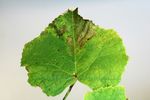Commercial Grape Downy Mildew Management - UT Extension
←
→
Page content transcription
If your browser does not render page correctly, please read the page content below
W 887
Commercial Grape Downy Mildew Management
Ty Smith, Graduate Research Assistant
Zachariah Hansen, Assistant Professor and Extension Specialist
Entomology and Plant Pathology
David Lockwood, Professor and Extension Specialist
Department of Plant Sciences
Disease Overview Diagnosing Downy Mildew
Downy mildew is a serious disease of grapes Downy mildew can infect all green, actively
caused by the oomycete Plasmopara viticola. It growing parts of the vine that have mature,
can infect all green parts of the vines including functional stomata that are used for air
leaves and young berries. Downy mildew causes exchange. Lesions on younger leaves initially
direct losses by damaging fruit and shoots and appear as slightly dark or yellow, circular and
indirect losses by prematurely defoliating vines, angular, and tissue within lesions quickly
leading to reduced yield and quality and becomes necrotic (dies) (Figure 1). On older
predisposing vines to winter damage. The leaves lesions may appear darker and are
disease is favored by warm and wet conditions typically delimited by veins (angular)
during vegetative growth of the vine. The (Figure 2).
pathogen overwinters as thick-walled survival
spores, called oospores, in fallen leaves and soil.
Downy mildew management is aided by cultural
practices that reduce leaf wetness and limit
sources of initial inoculum, but fungicides are
still required for satisfactory control when
susceptible varieties are grown in a favorable
climate for disease, such as Tennessee. Of
course, there are several other important
diseases and pests that can affect grapes grown
in the Mid-South and Southeast, which should Figure 1. Lesions on a younger grape leaf caused by downy
be factored into a comprehensive integrated mildew. Lesions are slightly dark or yellow, circular or angular,
pest management program. and quickly become necrotic.
Generally, cultural practices described here will
aid in the management of other diseases like
black rot and botrytis. Additionally, several Figure 2. Angular
fungicides recommended for downy mildew lesions on top of a
management, such as azoxystrobin, captan and grape leaf caused by
downy mildew.
mancozeb, have activity against other common Lesions are typically
diseases like black rot and bitter rot. More dark and delimited by
information can be found on these and other veins (angular).
grape production considerations in the
Additional Resources section at the end of
this publication.Affected leaf tissue eventually becomes
completely necrotic (Figure 3). Sporulation
occurs beneath lesions on the underside of the
leaves following humid, damp nights and .
appears as dense, cottony, white masses
(Figures 4 and 5). Sporulation can easily be seen
with the naked eye (Figure 4). If left
unmanaged, premature defoliation can occur.
Figure 5. Sporangia of the grape downy mildew
pathogen, Plasmopara viticola, viewed under a
microscope.
Figure 3. Severe leaf necrosis caused by advanced
downy mildew infection.
Figure 6. Downy mildew damage on bunch grapes.
Figure 4. Cottony white spore masses on the
Management
underside of grape leaves infected with downy
mildew.
Cultural Control
Young berries are highly susceptible to downy Site selection and canopy management
mildew and can become covered in white, practices that promote rapid drying of leaves,
cottony masses of sporulation under humid inflorescences and berry clusters help limit the
conditions. As berries mature, they become less potential for infection and disease spread.
susceptible to direct infection, but they can still Locating the vineyard on a site with a higher
be infected by the susceptible pedicels (the relative elevation than surrounding land
structure connecting each berry to the promotes good air flow out of the vineyard.
inflorescence), leading to a brown rot or leather Planting on a mild slope (2-5 percent gradient)
berry symptom. Infected berries usually fall off will result in better air flow than flat ground.
(Figure 6). A slight slope is mild enough that safe operation
of equipment is still possible. Vineyards should
be planted in areas of full sun, and any
Commercial Grape Downy Mildew Management 2impediments to air flow, such as hedgerows, to start as early as bud break and new shoot
fencerows or ditches, should be cleaned up to expansion and continue on a seven-to-10-day
promote better air flow through the vineyard. schedule until prebloom. Mancozeb is a good
choice for early-season applications. Prebloom
Select trellis designs and vine training systems
is an important time to begin protecting newly
that will promote better air circulation. Proper
developing berries from downy mildew
pruning practices and canopy management
infection. An additional application may need to
techniques will promote sunlight penetration, air
be made during bloom if the duration of bloom
movement and spray coverage throughout the
is long and/or conditions during bloom are
canopy. When using divided canopy systems,
especially favorable for disease. Postbloom is
such as Geneva double curtain or lyre trellis,
also an important time to protect developing
keep the area between the two areas of foliage
fruit from downy mildew infection. A postbloom
cleared through shoot positioning and summer
spray should include mancozeb plus a FRAC
pruning to help promote sunlight, air flow and
group 3 (DMI) or 11 (QoI) fungicide for increased
spray penetration into the canopy. See the
efficacy.
University of Tennessee Extension publication,
PB 1475: Grape Growing in Tennessee for more Alternatively, a product containing an active
information on site selection. ingredient targeted for oomycetes may be used
(Ridomil, Revus, Forum, Zampro). Cover sprays
During the dormant season, leaves should be
should continue at 10-to-14-day intervals after
shredded, removed or buried to reduce
the postbloom spray, but captan may need to
overwintering inoculum. Urea can be applied to
be substituted for mancozeb if the season limit
the canopy and ground at three-fourths
for mancozeb has been reached or to satisfy the
defoliation at a rate of 4-5 lb/A to encourage
preharvest interval (PHI). By this time
the breakdown of leaf material. In early season,
(approximately 40 days after bloom), fruit
mulches and removal of low-lying foliage can
should have matured to the point that they are
help reduce the spread of primary inoculum
no longer susceptible to downy mildew.
onto susceptible tissue as well as promote
However, foliage, rachises and pedicels (the
canopy drying. Destruction and removal of
main axis of the berry cluster and the structure
inoculum reservoirs, such as wild or feral
connecting each berry to the inflorescence,
grapevines or abandoned vineyards, reduce
respectively) are still susceptible, which can lead
inoculum potential. Overhead irrigation should
to premature defoliation and brown rot
be avoided. Proper soil drainage will minimize
symptoms on fruit.
standing water that promotes the spread of the
pathogen. Sprays should continue on a 10-to-14-day
interval up to preharvest (10 to 14 days before
Chemical Control harvest). Postharvest sprays should continue on
Pesticide labels and recommendations are a 14-to-21-day interval to avoid premature
frequently updated and revised. Therefore, the defoliation, which can predispose vines to
latest Southeast Regional Bunch Grape winter injury. Copper is a good choice for
Integrated Management Guide, available at postharvest sprays.
smallfruits.org/ipm-production-guides, should
be checked for the most up-to-date
recommendations.
Downy mildew can appear early in the season
depending on environmental conditions and
inoculum pressure. Protectant sprays may need
Commercial Grape Downy Mildew Management 3Fungicides recommended for managing downy mildew in grape production.
Product Active FRAC Efficacy Max. Max. Re- Preharvest
ingredient(s) group consecutive apps. entry interval
apps. per interval (PHI)
season (REI)
Abound azoxystrobin 11 excellentR 1 9 4 hours 14 days
Pristine boscalid + 7+11 excellentR 2 5 12 hours 14 days
pyraclostrobin
Various captan M4 good 3 6 48 up to
hours harvest
Various Fixed copper N/A moderate see label see see see label
and Bordeaux label label
mixture
Ranman cyazofamid 21 excellent 1 6 12 hours 30 days
Tanos famoxadone + 11+27 moderateR 1 9 12 hours 30 days
cymoxanil
Sovran kresoxim- 11 moderateR 2 4 12 hours 14 days
methyl
Various mancozeb M3 excellent see label see see see label
label label
Revus mandipropamid 40 excellentR 2 4 4 hours 14 days
Forum dimethomorph 40 excellent 1 4 12 hours 14 days
Zampro* dimethomorph 40+45 excellent 2 4 12 hours 14 days
+ ametocradin
Revus mandipropamid 40+3 excellent 2 4 12 hours 14 days
Top* +
difenoconazole
Ridomil mefenoxam + 4+M1 excellent 2 4 48 42 days
Gold copper hours
Copper
Ridomil mefenoxam + 4+M excellent 2 4 48 66 days
Gold MZ mancozeb hours
Various phosphonate N/A good see label see see see label
label label
Flint trifloxystrobin 11 moderate 2 6 12 hours 14 days
Ziram ziram M3 good 2 7 48 21 days
hours
R
Resistance has been reported in southeastern states.
*Check tank mix requirements on product label.
Commercial Grape Downy Mildew Management 4Additional Resources Lockwood, D.W. and Robinson, D.K. PB 1475:
Grape Growing in Tennessee. University of
2020 Southeast Regional Bunch Grape Tennessee Extension.
Integrated Management Guide. Ed. Nita, M.
Diagnostic images available at
2020. https://smallfruits.org/ipm-
https://www.ipmimages.org/search/action.cf
production-guides/
m?q=grape+downy+mildew
Precautionary statement: To protect people and the environment, pesticides should be used safely. This is everyone’s
responsibility, especially the user. Read and follow label directions carefully before you buy, mix, apply, store or dispose
of a pesticide. According to laws regulating pesticides, they must be used only as directed by the label.
**Disclaimer
This publication contains pesticide recommendations that are subject to change at any time. The recommendations in
this publication are provided only as a guide. It is always the pesticide applicator's responsibility, by law, to read and
follow all current label directions for the specific pesticide being used. The label always takes precedence over the
recommendations found in this publication.
Use of trade or brand names in this publication is for clarity and information; it does not imply approval of the product
to the exclusion of others that may be of similar, suitable composition, nor does it guarantee or warrant the standard of
the product. The author(s), the University of Tennessee Institute of Agriculture and University of Tennessee Extension
assume no liability resulting from the use of these recommendations.
UTIA.TENNESSEE.EDU
W 887 04/20 Programs in agriculture and natural resources, 4-H youth development, family and consumer sciences, and resource development.
University of Tennessee Institute of Agriculture, U.S. Department of Agriculture and county governments cooperating. UT Extension provides
equal opportunities in programs and employment.You can also read

























































